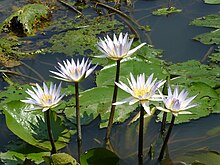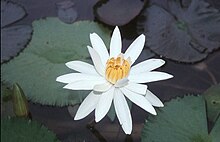The national flower and national emblem of Bangladesh is the Shapla or White Water Lily Nymphaea nouchali. The national emblem of Bangladesh was adopted shortly after independence in 1971.
Located on the emblem is a water lily, that is bordered on two sides by rice sheaves. Above the water lilly are four stars and a three connected jute leaves. The water lily is the country's national flower, and is representative of the many rivers that run through Bangladesh. Rice represents its presence as the staple food of Bangladesh, and for the agriculture of that nation. The four stars represent the four founding principles that were originally enshrined in the first constitution of Bangladesh in 1972: nationalism, secularism, socialism, and democracy.
The national emblem of the Republic is the national flower Shapla (nympoea-nouchali) resting on water, having on each side and ear of paddy and being surmounted by three connected leaves of jute with two stars on each side of the leaves.
Nymphaea nouchali, commonly known as the Red and blue water lily, Blue star water lily, Star lotus, or by its synonym Nymphaea stellata, is a water lily of genus Nymphaea.
.jpg/220px-Nymphaea_nouchali_(1).jpg) This aquatic plant is native to the Indian Subcontinent area. It was spread to other countries already in ancient times and has been long valued as a garden flower in Thailand and Myanmar to decorate ponds and gardens. In its natural state the Red and blue water-lily is found in static or slow-flowing aquatic habitats of little to moderate depth.
This aquatic plant is native to the Indian Subcontinent area. It was spread to other countries already in ancient times and has been long valued as a garden flower in Thailand and Myanmar to decorate ponds and gardens. In its natural state the Red and blue water-lily is found in static or slow-flowing aquatic habitats of little to moderate depth.Description
Nymphaea nouchali is a day blooming nonviviparous plant with submerged roots and stems. Part of the leaves are submerged, while others rise slightly above the surface. The leaves are round and green on top; they usually have a darker underside. The floating leaves have undulating edges that give them a crenellate appearance. Their size is about 20–23 cm and their spread is 0.9 to 1.8 m.
 This water-lily has a beautiful flower which is usually violet blue in color with reddish edges. Some varieties have white, purple, mauve or fuchsia-colored flowers. The flower has 4-5 sepals and 13-15 petals that have an angular appearance making the flower look star-shaped from above. The cup-like calyx has a diameter of 11–14 cm.
This water-lily has a beautiful flower which is usually violet blue in color with reddish edges. Some varieties have white, purple, mauve or fuchsia-colored flowers. The flower has 4-5 sepals and 13-15 petals that have an angular appearance making the flower look star-shaped from above. The cup-like calyx has a diameter of 11–14 cm.Symbolism
Nymphaea nouchali is the National flower of Bangladesh (where it is known as "Shapla") and Sri Lanka (where it is known as Nil Mānel or "Nil Mahanel"). Since "Nil" means ‘blue’ in Sinhala, the Sinhalese name of this plant is often rendered as "blue lotus" in English.
In Sri Lanka this plant usually grows in buffalo ponds and natural wetlands. Its beautiful aquatic flower has been mentioned in Sanskrit, Pali and Sinhala literary works since ancient times under the names "Kuvalaya", "Indhīwara", "Niluppala", "Nilothpala" and "Nilupul" as a symbol of virtue, discipline and purity. Buddhist lore in Sri Lanka claims that this flower was one of the 108 auspicious signs found on Prince Siddhartha's footprint. It is said that when Buddha died, lotus flowers blossomed everywhere he had walked in his lifetime. The star lotus might have been one of the plants eaten by the Lotophagi of Homer's Odyssey.
 The Red and blue water-lily is used as an ornamental plant because of its spectacular flowers. It is also popular as an aquarium plant under the name "Dwarf Lily" or "Dwarf Red Lily". Sometimes it is grown for its flowers, while other aquarists prefer to trim the lily pads, and just have the underwater foliage.
The Red and blue water-lily is used as an ornamental plant because of its spectacular flowers. It is also popular as an aquarium plant under the name "Dwarf Lily" or "Dwarf Red Lily". Sometimes it is grown for its flowers, while other aquarists prefer to trim the lily pads, and just have the underwater foliage. Nymphaea nouchali is considered a medicinal plant in Indian Ayurvedic medicine under the name Ambal; it was mainly used to treat indigestion. Recent experiments have confirmed that it has medicinal qualities as an antihepatotoxic and antidiabetic. Like all waterlilies or lotuses, its tubers and rhizomes can be used as food items; they are eaten usually boiled or roasted. In the case of the Red and blue water-lily, its tender leaves and flower peduncles are also valued as food.
Nymphaea nouchali is considered a medicinal plant in Indian Ayurvedic medicine under the name Ambal; it was mainly used to treat indigestion. Recent experiments have confirmed that it has medicinal qualities as an antihepatotoxic and antidiabetic. Like all waterlilies or lotuses, its tubers and rhizomes can be used as food items; they are eaten usually boiled or roasted. In the case of the Red and blue water-lily, its tender leaves and flower peduncles are also valued as food.The dried plant is collected from ponds, tanks and marshes during the dry season and used in India as animal forage.

.jpg/220px-Nymphaea_nouchali_(2).jpg)












0 comments:
Post a Comment